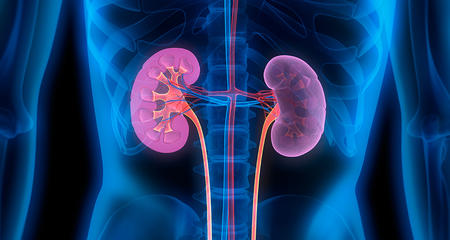Adrenal glands are small hormone-producing glands located above each kidney. Each adrenal gland is composed of two separate regions — the adrenal medulla and the adrenal cortex.
- The adrenal medulla produces the hormones that regulate the body’s reaction to stress. The medulla produces epinephrine and norepinephrine, which are commonly called adrenaline and noradrenaline.
- The adrenal cortex produces hormones that affect blood sugar levels, blood pressure and some sexual characteristics. The cortex produces steroid hormones such as cortisol, aldosterone and androgens.
The adrenal glands interact with the hypothalamus and pituitary gland in the brain. The hypothalamus produces hormones that stimulate the pituitary gland. In turn, the pituitary gland produces hormones that stimulate the adrenal glands to produce hormones.
Disorders of the adrenal glands include adrenal nodules, overactive adrenal glands and underactive adrenal glands.
Adrenal Nodules
Adrenal nodules — lumps that develop in the adrenal glands — are seen in up to 5 – 7% of people who undergo abdominal imaging scans. Most adrenal nodules are benign (non-cancerous). Some benign adrenal nodules can overproduce adrenal hormones that may cause adverse health consequences. The most common adrenal hormones that are overproduced are cortisol and aldosterone.
At Froedtert Hospital, our multidisciplinary Adrenal Clinic includes endocrinologists and endocrine surgeons who evaluate patients with adrenal nodules.
Overactive Adrenal Gland Disorders
A nodule in the adrenal glands can result in the overproduction of adrenal hormones.
Hypercortisolism
Hypercortisolism is a condition where the adrenal glands produce too much of the hormone cortisol and can lead to Cushing’s syndrome. Depending on the degree of excess cortisol, the following hypercortisolism symptoms may develop.
- Muscle weakness
- Purple stretch marks over the skin
- Rounded face
- Fatty hump between the shoulders and above the clavicles
Excess cortisol can also cause high blood sugar, high blood pressure and weak bones. Treatment of Cushing’s syndrome typically involves surgery. Medications can be considered in certain cases.
Primary Hyperaldosteronism
Primary hyperaldosteronism is a condition where one or both adrenal glands produce too much of the hormone aldosterone. Primary hyperaldosteronism is the most common cause of secondary hypertension (or high blood pressure). In addition to high blood pressure, primary hyperaldosteronism can cause symptoms such as:
- Fluid retention
- Lower levels of potassium in the blood
- Enlarged heart, if left untreated
Treatment options for primary hyperaldosteronism include surgery or medications depending on if one or both adrenal glands are overactive.
Pheochromocytoma
Pheochromocytoma is a rare, usually benign, tumor of the adrenal glands resulting in the overproduction of the hormones adrenaline and noradrenaline. Pheochromocytomas can cause symptoms such as:
- High blood pressure
- Sweating
- Headache
- Chest pain
- Anxiety
About 10 percent of pheochromocytomas are cancerous and have the potential to spread to other parts of the body. There may be a family history of this disease. Treatment of pheochromocytoma typically involves surgery.
Underactive Adrenal Gland Disorders
The adrenal glands may fail to produce adequate levels of cortisol for many reasons resulting in a condition called adrenal insufficiency. The problem may be related to a disorder of the adrenal glands themselves or due to inadequate stimulation of the adrenal glands by the pituitary gland. Symptoms of adrenal insufficiency include:
- Fatigue
- Weight loss
- Poor appetite
- Weakness
- Gastrointestinal problems.
Froedtert & MCW endocrinologists are experienced in diagnosing and treating all disorders that result in underactive adrenal glands:
- Polyglandular autoimmune syndrome Type 1 and Type 2
- Primary adrenal insufficiency (Addison’s disease)
- Secondary adrenal insufficiency
- Congenital adrenal hyperplasia
Tests to Diagnose Adrenal Gland Disorders
Specialized tests may be used in the diagnosis of adrenal gland disorders.
Adrenal Vein Sampling
Adrenal vein sampling (AVS) is a minimally invasive procedure that assesses if one or both adrenal glands are overactive in primary hyperaldosteronism and in select cases of hypercortisolism. Blood samples are collected through a catheter (thin tube) from each adrenal vein to determine how active the glands are and if one gland is more active than the other.
Cosyntropin Stimulation Test
Cosyntropin stimulation tests measure the adrenal glands’ stress response to adrenocorticotropic hormone (ACTH). This hormone, produced in the pituitary gland, stimulates the adrenal glands to release cortisol. During the test, a small amount of synthetic ACTH is injected, and the amount of cortisol produced by the adrenal glands in response is measured. This test is used to diagnose or rule out primary and secondary adrenal insufficiency, Addison’s disease and related conditions.
Dexamethasone Suppression Test
Dexamethasone suppression test (DST) is a blood test that assesses the response of the adrenal glands to dexamethasone. For this test, the patient takes a pill of dexamethasone at bedtime and the cortisol level in the blood is measured the next morning. This test is used to diagnose or rule out excessive cortisol production from an adrenal nodule.
Treatment of Adrenal Gland Disorders
For adrenal nodules and overactive adrenal gland disorders, Froedtert & MCW endocrinologists and surgeons work as a team.
Surgical options include:
- Laparoscopic adrenalectomy, a minimally invasive procedure to remove the adrenal glands
- Adrenal sparing surgery — removal of the tumor in the adrenal gland, while sparing normal adrenal tissue
For underactive adrenal gland disorders, we may prescribe steroid hormone replacement therapy.
Blogs, Patient Stories, Videos and Classes





